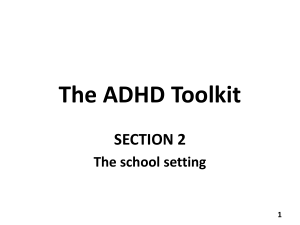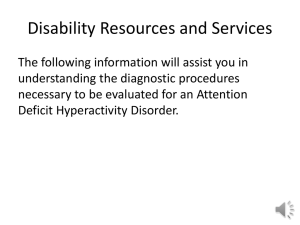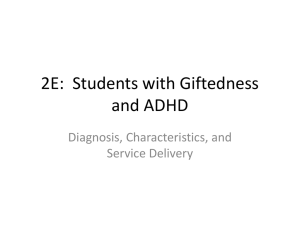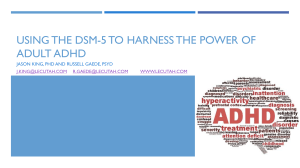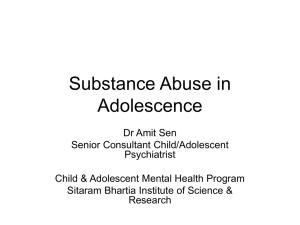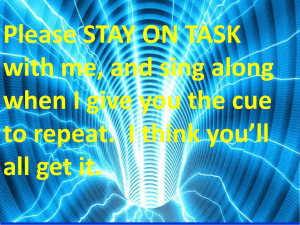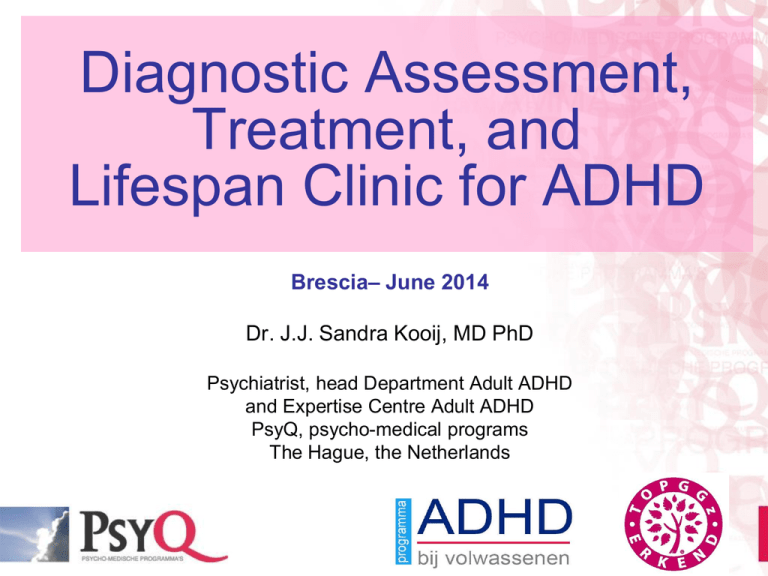
Diagnostic Assessment,
Treatment, and
Lifespan Clinic for ADHD
Brescia– June 2014
Dr. J.J. Sandra Kooij, MD PhD
Psychiatrist, head Department Adult ADHD
and Expertise Centre Adult ADHD
PsyQ, psycho-medical programs
The Hague, the Netherlands
Topics
•
•
•
•
•
•
Clinical picture
Gender and age
Prevalence
Diagnostic assessment, DIVA 2.0
Differential diagnosis
Circadian rhythm disturbances in ADHD and
relationship with mood and health
• Treatment
• Lifespan Clinic for ADHD
Adult ADHD
Diagnostic Assessment and Treatment
Including DIVA 2.0
JJS Kooij, 3rd edition
2012
www.springer.com
Search for ‘Adult ADHD’
Clinical picture of ADHD
Lifetime symptoms of Attention-Deficit/Hyperactivity Disorder:
• Inattention: distracted, chaotic, forgetful, late, difficulty
making decisions, organising and planning, no sense of
time, procrastination
• Hyperactive: (inner) restlessness, tense, talkative, busy;
coping by: excessive sporting/alcohol abuse/avoiding
meetings
• Impulsive: acting before thinking, impatient, difficulty
awaiting turn, jobhopping, binge eating, sensation seeking
In addition in 90% of adults, lifetime:
• Moodswings (5x/day) and Anger outbursts
APA 1994; Kooij 2001; Conners 1996
Decrease of hyperactivity
Hyperactivity is adjusted, compensated for, or experienced as more
‘inner restlessness’:
•
•
•
•
•
Avoiding meetings where you have to sit stil
Excessive sporting
Hectic job full of change
Cannabis / alcohol / tranquillisers against restlessness
Talkativeness, inner restlessness
The decrease in marked outward visible hyperactivity has presumably been
the reason why we mistakenly have thought that ADHD was
outgrown
Inattention most invalidating
symptom in adults
Adults need more attention than children:
•
•
•
•
•
•
•
Procrastination
Chaos
Difficulty organising
Being late
Difficulty reading and remembering
Forgetting things or appointments
Using no watch or agenda!
ADHD in DSM-IV
• Attention-deficit/hyperactivity disorder
• 18 criteria: 9 attention problems (A) and 9
hyperactive/impulsive criteria (HI)
• Diagnosis in childhood from 6/9 of one or both
domains
3 subtypes:
• ADHD, inattentive type (also ADD) (10-15%)
• ADHD, hyperactive/impulsive type (3%)
• ADHD, combined type (85%)
DSM-5 changes in ADHD
Subtypes = now
Presentation types
Cutoff adolescents & adults 5/9
Age of onset
< 12 years
ADHD + ASS
Severity
NEURODEVELOP
MENTAL
DISORDERS
More examples
of behaviour
Impairment in ≥ 2 situations, but
more situations given
Impairment in adult ADHD
In clinical as well as epidemiological samples compared to NCs:
•
•
•
•
•
•
•
•
Learning problems (60%)
Less graduated
Lower education
Lower income
Less employed, more sickness leave
More job changes (longest job 5 yrs)
More often arrested, divorced and more social problems
More driving accidents, teenage pregnancies, suicide
attempts
• Higher (mental) health care costs
Biederman 2006; Kooij 2001, 2005; Barkley 2002; Manor, 2010
ADHD and gender:
Men more often ADHD?
Children
M:F
Adults
M:F
Clinical studies
2-9x
1-2x
General
population
studies
2-3x
1 - 1.5x
Taylor 2004; Nice guidelines 2008; Kessler 2006;
Fayyad 2007; Kooij 2005
Gender differences
children and adults
Childhood
M>>F
Adulthood
M=F
Underdiagnosis in girls
Prevalence (%)
Girls have more ADD
100
90
80
70
60
50
40
30
20
10
0
Combined
Hyperactive/ impulsive
Inattentive
Girls with ADHD
(n=140)
Boys with ADHD
(n=140)
Biederman 1994, 2004
Causes of underdiagnosis of
ADHD in girls
Referral bias
ADD subtype
Internalising
comorbidity
(depression, anxiety,
premenstrual dysphoric disorder)
Complaints girls and women
with AD(H)D
Chaotic
PMDD
Distracted
Overwhelmed
No Overview
Moodswings
ADD
Tired
Low selfesteem Lazy
Unmotivated
Depressed
Panic
Girls and women 2x more
often ADHD inattentive type
• But majority has still ADHD combined type
• Women have to organise themselves, family,
household, childrens’ agenda’s and their job
• Being a women with ADHD is ‘a job from hell’,
always late, forgetting things …
• Chaos and tiredness their daily bread
• Low selfesteem and uncertainty about
capabilities the result
Room with a view?
Is ADHD like Chronic Fatigue Syndrome
(CFS)?
Inattentive girls referred for being´tired´?
• Clinical studies: boys more often ADHD
• Epidemiological research: girls similar percentage ADHD as boys
ADHD in girls is less well known, and their behaviour less disruptive
than in boys …
Boys have more often:
• ADHD, combined type
• More severe hyperactivity
• Externalising comorbidity (oppositional defiant or aggressive behaviour)
Being disruptive helps to get help….
Biederman ea, 1994; 2002, 2004; 2005
Girls are not disruptive …
Inattention takes continuous mental effort,
leading to exhaustion …
… but
may be chronically tired!
ADHD and CFS need
further study
• Screening for ADHD in Burnout or CFS
group
• Methylphenidate treatment in subgroup
with diagnosis of ADHD may ameliorate
tiredness and inattention
• Physical complaints in ADHD need further
study (RSI, burnout, neck- and backpains,
obesity, chronic tiredness, chronic sleepproblems)
BOOKS on GIRLS & WOMEN & ADHD
ADHD in older
adults
An epidemiological study by M. Michielsen,
E. Semeijn, H. Comijs, D.J.H. Deeg,
A. Beekman, J.J.S. Kooij
ADHD IS NOT OUTGROWN
?
Fayyad J Br J Psychiatry. 2007 May;190:402-9; Kooij JJS Psychol Med. 2005 Jun;35(6):81727; Kessler RC J Occup Environ Med. 2005 Jun;47(6):565-72.; Kessler RC Am J Psychiatry.
2006 Apr;163(4):716-23.
Prevalence of ADHD in
children and adults
Children
• USA
3 - 7%
Adults
• USA
• 10 countries (mean)
4 - 5%
3.4%
APA 2000; Faraone 2003; Kessler 2006; Murphy & Barkley, 1996;
Kooij 2005; Fayyad 2007
Age-Specific Prevelence of ADHD
Persistence Remission
of ADHD depends
on definition of remission
70
Syndromatic
60
Symptomatic
% Remitted
50
Functional
40
30
20
10
0
<6
6 to 8
9 to 11
12 to 14
15 to 17
18 to 20
Age (year)
Biederman, 2000
Treatment % per country
in adults with ADHD
Medical
treatment
Mental
treatment
Any
treatment
Treatment
for ADHD
Belgium
10.4
13.8
21.5
0
Italy
10.6
4.4
11.9
0
NL
18.6
18.8
23.8
1.9
USA
27.9
28.6
49.7
13.2
Fayyad 2007
Old people reporting childhood
ADHD symptoms
• Swedish sample, 1599 people aged 65-80 yrs
• WURS, cutoff ≥ 36
• Prevalence of self rated childhood ADHD
symptoms 3.3%, comparable to ADHD in children
and adults
• M > F (71 % vs 29%)
• Young = older groups
Taina Guldberg- Kjär, 2009
Old people reporting childhood
ADHD symptoms II
ADHD compared to no ADHD group:
•
•
•
•
more divorce/no relationship (34% vs 12%)
more childhood problems
more jobs (> 5)
worse current health, worse current memory
Taina Guldberg- Kjär, 2009
Dutch epidemiological
study ADHD in adults
•
•
•
•
N=1800, age 18-75
Self reported DSM-IV ADHD-Rating Scale
Prevalence 1 - 2.5% (cutoff 6, resp. 4 current symptoms)
Hyperactivity: small, significant age dependant decline, but
not for Inattention and Impulsivity
• Group 60-75 yrs = 17.7% of the study population
• Prevalence in this oldest group 0.3 - 3% (cutoff 6, resp. 4
current symptoms)
Kooij ea 2005
Case studies in older adults
• Case studies in older adults indicate
similar symptoms and impairment in old
age and similar treatment response
• Epidemiological and controlled clinical
trials lacking
- Manor I. Clin. Neuropharmacology 2011
- Biederman J. JAMA 1998
- Da Silva M.A. Journal of Attention Disorders 2008
- Parker R. JAMA 1999
- Brod M. Qual Life Res 2011
ADHD in older adults
An epidemiological study by M.
Michielsen, E. Semeijn, H. Comijs,
D.J.H. Deeg, A. Beekman, J.J.S.
Kooij
Michielsen 2012, 2013;
Semeijn 2013a,b
Marieke Michielsen & Evert Semeijn
Presenting their posters in Berlin, ADHD Congress, 2011
Study on the prevalence of
ADHD in older people
• Data were used from the
Longitudinal Aging Study
Amsterdam (LASA)
• Collection started in 1992/93
• Physical, emotional, cognitive and
social functioning
• Follow-up every three years
Methods
Two - phase design: screening and diagnostic
interview
Phase 1
Screening list sample
N=1494
Low scoring group
Invited
N=94
Medium scoring group
Invited
N=93
Refused: 7
Unable: 2
High scoring group
Invited
N=84
Refused: 12
Unable: 2
Deceased : 1
Refused: 12
Deceased : 1
Phase 2
Interviewed
Phase 2
Interviewed
Phase 2
Interviewed
N=85
N=80
N=69
Screening list by Barkley
1
Is often easily distracted by extraneous stimuli or irrelevant thoughts
2
Often makes decisions impulsively
3
Often has difficulty stopping his or her activities or behaviour when he or she
should do so
4
Often starts a project or task without reading or listening to directions carefully
5
Often shows poor follow-through on promises or commitments he or she may
make to others
6
Often has trouble doing things in their proper order or sequence
7
Often more likely to drive a motor vehicle much faster than others (excessive
speeding)
Alternative: Often has difficulty engaging in leisure activities or doing fun things
quietly
8
Often has difficulty sustaining attention in tasks or play activities
9
Often has difficulty organizing tasks and activities
Barkley RA, Murphy KR, Fischer M. ADHD in adults: What the science
says. The Guilford Press; 2007.
ADHD diagnoses
Two diagnostic categories, based on DIVA 2.0
were used:
Syndromatic ADHD, full blown DSM-IV diagnosis
- 6/9 symptoms in present time and childhood
Symptomatic ADHD, sub-clinical diagnosis
- 4/9 symptoms in present time and 6/9 childhood
Prevalence of ADHD in older people in
the general Dutch population
Age: 61-95 years: lower prevalence of ADHD in
the older old.
Women: 59%
Syndromatic ADHD
Symptomatic ADHD
%
95% Cl
%
95% Cl
2.8
0.86–4.64
4.2
2.05–6.39
Men
3.0
-0.20–6.12
4.6
0.96–8.39
Women
2.6
0.38–4.72
3.8
1.39–6.24
Total
Sex
Michielsen 2012
ADHD and anxiety/depression
in older people
• ADHD was associated with more anxiety
and depressive symptoms crosssectionally as well as longitudinally
compared to controls.
Michielsen 2013
ADHD and physical health in
older people
• ADHD in older people was associated with
chronic nonspecific lung diseases
(CNSLD), cardiovascular diseases, and
number of chronic diseases.
• ADHD was negatively associated with selfperceived health.
Semeijn 2013
ADHD and social functioning
in older people
ADHD in older people:
• was associated with being divorced or never married
• less family members in their network
• emotional loneliness
Level of ADHD symptoms was associated with more
• emotional and social loneliness
• lower income level
• NB depressive symptoms play an important role in the
association between ADHD and loneliness
Michielsen, submitted
Conclusions
• The prevalence and comorbidity with anxiety
and depression in older people with ADHD,
show similar patterns as in younger age groups
• Regarding physical health there are indications
that older people with ADHD may have worse
health outcomes and may die younger
• Lower income, less intimate relationships, less
family relationships, more loneliness and
depression in older people with ADHD
Impairment is
not
diminishing
Similar
prevalence
rates
ADHD is not
outgrown
in older people
Similar
medication
response
RCT’s
needed
Lifespan clinics
needed!
Can ADHD be treated
in older people?
• 15 case studies: patients (m, f), age 67-81 yrs
• ADHD from childhood, diagnosis in
(grand)children, who respond favorable to
medication for ADHD
• Lifespan restlessness, irritability, impulsiveness
and distractedness leading to impairment
• Succesfully treated with stimulants in old age
• Monitoring cardiovascular side effects before
and during treatment
Wetzel 2008; Da Silva & Louza, 2008;
Standaert, Kok & Kooij, 2010; Manor ea, 2011
Implications for patient care
•
•
•
•
•
ADHD is not outgrown in older persons
Impairment is not diminishing
Similar prevalence rates across the lifespan (3-5%)
Lifespan patient services are needed
Case reports indicate similar response to
medication as in adults and children
• RCTs needed in older people with ADHD using
stimulants
• More research needed into the impact of ADHD
with age on social, psychiatric and somatic
functioning
COMORBIDITY in ADHD
Comorbidity in adults with ADHD
ADHD comes seldom alone:
• 75% at least one other disorder
• 33% two or more
Mean: 3 comorbid disorders
Biederman 1993; Kooij 2001, 2004
Comorbidity in ADHD?
•
•
•
•
•
•
•
•
Depression (60% SAD)
Bipolar Disorder (88% BP II)
Anxiety Disorders
SUD
Smoking
Cluster B Pers. Disorders
Sleeping Problems (DSPS)
Muscle, joint, neck- and backpain
20-55%
10%
20-30%
25-45%
40%
6-25%
75%
??
Biederman 1991,1993, 2002; Weiss 1985; Wilens 1994; Kooij
2001, 2004; van Veen 2010; Amons 2006
The other way round: ADHD is comorbid
in 20% of psychiatric patients
•
•
•
•
SUD:
Anxiety disorders:
Bipolar II:
Borderline PD:
20% (Trimbos Institute)
20% (PsyQ)
20% (PsyQ)
35% (Radboud University)
And in accordance to epidemiological data USA: 20%
vd Glind 2005; Rops 2010 in prep; Roodbergen 2010 in prep;
Fones 2004; van Dijk 2010 in prep; Kessler APA 2007; Fayyad
2007
12 month comorbidity with ADHD
in adults, epidemiological study USA
OR
% ADHD
% comorbid D
in comorbid D in ADHD
_____________________________________________
Mood Ds
3.8* 20.4
31.7
Anxiety Ds
3.8* 17.1
51.1
SUDs
2.8* 18.1
14.2
1 Disorder
2 Disorders
3+ Disorders
Any disorder
3.0*
3.9*
8.3*
4.4*
11.6
14.5
26.5
15.9
24.5
14.4
26.6
66.3
Kessler, APA 2007
OR for comorbidity in active ADHD
compared to ADHD, in remission
Active ADHD
ADHD in remission
9
8,2*
8
7
6,2
6
OR
5
4
3,9*
3,9*
3,9
4,3*
3,5
2,5
3
1,6
2
1,2
1
0
Any Mood
D
Depr
Panic/GAD
BP I /II
PTSD
Kessler, APA 2007
Conclusions
Epidemiological study Kessler
• 1 in 5 mood disorders are comorbid with ADHD
• Depression is comorbid in 30% of ADHD
• ADHD has an earlier onset than mood, anxiety or
SUDs
• ADHD is a riskfactor for a range of comorbid
disorders
• Treatment/remission of ADHD leads to lower
occurence of mood-, panic disorder, and PTSD
Kessler APA 2007
ADHD or Borderline?
Overlap
• Impulsivity is hallmark of both
• Frequent moodswings & irritability in 90% of adults with ADHD
Differential diagnosis
• Inattention and hyperactivity only in ADHD
• ADHD starts in childhood, borderline in adolescence
• Emptiness, manipulative behaviour, all good-all bad patterns
specific to borderline
• History of neglect or sexual abuse typical in borderline, not ADHD
Comorbidity
• 6-25% of adults with ADHD also have cluster B personality disorder
• 35% of borderline patients also have ADHD
Kooij 2006; van Dijk in prep, 2009
Chance of addiction
ADHD vs controls
40
35
%
30
25
20
15
10
5
0
Controls
With med.
Without med.
(n=45)
Wilens, 2003
Likelyhood
Substance Use Disorder:
Age at onset in ADHD compared to
controls
1
0.9
0.8
0.7
0.6
0.5
0.4
0.3
0.2
0.1
0
ADHD
Controls
p<0.05
0
10
20
30
Age at onset
Wilens 1997
40
50
60
ADHD and SUD
• Medication treatment of ADHD does not
increase chance of SUD
• Research suggest a protective effect of
stimulants against substance abuse
Wilens 2003
ADHD & the circadian
rhythm in adults with ADHD
Implications for sleep, mood and health
J.J. Sandra Kooij, MD PhD
Psychiatrist, Head Dutch Expertise Center
Adult ADHD, PsyQ, psycho-medical programs
The Hague, The Netherlands
Adult ADHD is highly comorbid
with circadian based disorders
75% has comorbidity (mean 3 disorders):
•
•
•
•
•
•
•
•
Depression (60% SAD)
Anxiety
Substance Use Disorders
Personality Disorders
Eating Disorders (BN)
Binge eating
Obesity
Sleepproblems, DSPS pattern
25-50%
25%
20-45%
6-25%
9%
86%
30%
75%
Kooij 2001 NTG;145(31):1498-501; Kooij 2004, Psychol Med;34(6):97382, Kooij 2012, book Adult ADHD; van Veen 2010, Biol Psychiatry 67(11):
1091-6; Biederman 1993, AJP;150(12):1792-8; Kessler 2006, AJP;163(4)
:716-23; Pagoto 2009, Obesity;17(3):539-44. Davis 2009, J Psychiatr
Res;43(7):687-96. Kooij & Bijlenga, in press.
ADHD and sleepproblems in children
Subjective measures:
•
•
•
•
•
Sleep onset latency / bedtime
resistance
Difficulty waking up
Fragmented sleep
Decreased sleep efficiency
Excessive daytime sleepiness
Corkum 1998, JAACAP;37(6):637-46;Corkum 1999,
JAACAP;38(10):1285-93; Corkum 2001, Sleep;24(3):303-12;
Konofal 2007, Sleep Med;8(7-8):711-5; Philipsen 2006, Sleep
Med Rev, 10(6):399-405; Gaultney 2005, Behav Sleep
Med;3(1):32-43; Lecendreux 2000, J Child Psychol
Psychiatry;41(6):803-12; Golan 2004, Sleep;27(2):261-6;
Boonstra 2007, Sleep;30(4):433-42; Oosterloo 2006,
Psychiatry Res;143(2-3):293-7; van der Heijden 2005,
Chronobiol Int;22(3):559-70. Van der Heijden 2006, J Sleep
Res;15(1):55-62 ; Sobanski 2008, Sleep;31(3):375-81; Sadeh
2006, Sleep Med Rev;10(6):381-98.
Objective measures (MSLT, actigraphy, PSG, DLMO):
•
•
•
•
•
Excessive Daytime Sleepiness (EDS)
Periodic limb movement disorder (PLMD) / Restless Leg Syndrome (RLS)
Reduced % REM sleep
Obstructive Sleep Apnea Syndrome (OSAS)
Delayed Sleep Phase Syndrome (DSPS): DLMO 45 min delayed
Sleep questionnaire in
120 adults with ADHD
Difficulty …
•
•
•
•
•
going to bed on time:
falling asleep:
sleeping through:
getting up in the morning:
daytime sleepiness:
78%
70%
50%
70%
62%
This pattern lifetime in 60%, suggestive of
Eveningness or Delayed Sleep Phase Syndrome
Kooij, Society of Light Treatment and Biological Rhythms 2007
Chronotypes:
being a lark or an owl
•
•
•
•
•
•
•
Morningtype: gets up early, active in morning (20-25%)
Eveningtype: late to bed, active in evening (20-25%)
In between: 50%
Normal variation may differ +/- 2 hrs
More variation disallows normal participation in society
Clockgenes define chronotype and biological rhythm
Zeitgebers: light through the eyes in the morning, and
melatonin production in the brain at night synchronise us
with the light/dark cycle of the world
• Artificial light may delay melatonin production at night
(computer!)
Sleep phase delay in ADHD
30
25
20
normal type
eveningtype
15
10
Melatonin level
5
0
Time
Characteristics of
40 consecutive ADHD patients
Sleep Onset
Insomnia (SOI)
No SOI
N
31 (78%)
9 (22%)
Male
17 (55%)
4 (44%)
Age, mean (SD)
28.2 (7.6)
30 (11.9)
ADHD, combined type
29 (94%)
5 (56%)
ADHD, inattentive type
2 (6%)
4 (44%)
Alcohol (U/wk)
6.76
5.67
Nicotine (Sig/day)
8.16
1.11
Sleep diagnosis
ns
ns
Van Veen 2010, Biological Psychiatry;67(11):1091-6.
Dim Light Melatonin Onset (DLMO): delayed
N=40 adults with ADHD w/wo Sleep Onset Insomnia
versus healthy controls
DLMO
(hr ± sd)
ADHD
Total
SOI
no-SOI
HC
p:
ADHD
vs HC
p:
SOI
vs HC
22:57 ± 1:20
23:15 ± 1:19
22:00 ± 0:54
21:34 ± 0:45
0.000
0.000
- 78% of consecutive ADHD patients had SOI
- DLMO: 105 min later in SOI vs HC
- After DLMO, it generally takes 2 hours to fall asleep
Van Veen ea, 2010
24 hour movement patterns ADHD + SOI compared to controls (actigraphy)
Van Veen ea 2010
New study: core and skin temperature,
DLMO and activity patterns
• N=12 ADHD+DSPS (medication naïve) and 12 controls
• 5 consecutive days and nights
Results:
• More variable bedtimes in ADHD, but melatonin onset is the same
every day in both groups
• DLMO 1.5 hours later in ADHD
• Sleep duration 1 hr shorter on days before workdays in ADHD
• Second delay, between DLMO and sleep onset was ≥ 1 hr longer in
ADHD
• Melatonin, activity and temperature were all delayed to a similar
degree in ADHD
• Overall temperatures were lower in ADHD
• Colder hands in ADHD, related to sleep onset difficulties
Bijlenga, J Sleep Res, 2013 Aug 16
24 hr Activity,
Core and Skin
Temperature,
in ADHD versus
controls
Bijlenga, J Sleep Res 2013,
Aug 16
ADHD patients lack
any sense of time
Clinical experience: adults with ADHD seem to lack
any sense of time, as well as any rhythm in day/night
Their habitually being late has been regarded as part of
their inattentiveness, a planning problem, but may in fact
reflect a fundamental problem of the biological clock
Nucleus supra chiasmaticus
(NSC): the biological clock
Hypothalamic nucleus, just above the chiasma opticum
ADHD, circadian rhytm, sleep, mood and
season
ADHD
100%
DSPS
75%
Over
weight
SAD
BP II
30%
10%
Goikolea 2007, Psychol Med;37 (11):1595-9;
Amons 2006, J Affect Disord;91(2-3):251-5;
Lewy 2006, Proc Natl Acad Sci U S
A;103(19):7414-9;
Van Veen 2010, Biol Psychiatry 67(11):
1091-6
Bijlenga 2013, J Att Disord; 17(3):261-75
Bijlenga 2013, J Sleep Res. Aug 16 epub
ADHD and disturbed rhythms
ADHD may not only be associated with circadian, but also
with cyclical and seasonal disturbances, leading to
problems with impulsiveness, eating, sleeping and mood:
• Impulsivity/novelty seeking has been associated with eveningness
• Lack of sleep rhythm may lead to lack of rhythm in eating and activity
patterns as well
• Evening types, or those with a delayed sleep phase may prefer irregular
work or work in night-shifts, thereby increasing the sleep phase delay,
as well as obesity
• ADHD has a higher percentage of Seasonal Affective Disorder (SAD) or
winter depression, and possibly also of Premenstrual Dysphoric
Disorder than normal
Barkley 1997, J Dev Behav Pediatr,18(4):271-9;
Amons 2006, J Affect Disord;91(2-3):251-5
Caci 2004, Eur Psychiatry.;19(2):79-84.
Levitan 2004, Biol Psychiatry;56(9):665-9
Antunes 2010, Nutr Res Rev.(1):155-68.
Circadian disturbance, ADHD
and health
• ADHD is associated with chronic DSPS
• ADHD patients often work in night shifts or are active at night
• May be gene-environment interaction: circadian preference based
on (clock)genes and dopaminergic pathways
• But: chronic work (>30 yrs) in night shifts is associated with higher
risk of (breast)cancer
• Melatonin acts as a circadian anti-cancer signal at night
• Among others (light at night), chronic low melatonin levels may
protect less well against development of cancer
is ADHD a high riskgroup for cancer?
Schernhammer 2001, J Natl Cancer Inst;93(20):1563-8;
Schernhammer 2005, Eur J Cancer;41(13):2023-32; Hansen 2001, J
Natl Cancer Inst;93(20):1513-5; Blask 2005, Endocrine;27(2):179-88.
Moser 2006, Conf Proc IEEE Eng Med Biol Soc;1:424-8; Verkasalo
2005, Cancer Res;65(20):9595-600.
Short sleep and cancer risk
• Shift work is considered carcinogenic in the long term
(IARC 2007)
• Sleep loss by shiftwork is associated with higher
incidence of breast- and prostate cancer
• Short sleep
short exposure to and/or low levels of
melatonin
• Melatonin has anti-oxidative properties and protects
against cancer growth
• Animal research shows inhibiting effects of melatonin on
cancer growth and increased survival
• In humans, first studies with melatonin in cancer patients
ongoing
Schernhammer 2004, 2006; Parent ea 2012;
Sigurdardottir ea 2012; Anisimov ea 2012
Cancer risk and exposure
to light@night
• Use of artificial light at night stops melatonin production
through the eyes, feedback to pineal gland
• The light coming from TV, PC or Ipad also suppresses
melatonin production and delays natural sleep onset
easily by hours
• Light is the natural antidote to melatonin and wakes us
up every day …
• Timing of light may be crucial for health in general
• Women with total visual blindness have less cancer than
sighted women
Flynn-Evans ea, 2009
Hypothesized relations
Delayed rhythm
Shorter sleep duration
Lower melatonin levels
Less protected against cancer
Skipping breakfast
Binge eating
No rhythm in meals
Higher glucose levels
Obesity, DM,
Hypertension,
Cardiovascular
disease,
Cancer
Ramsey & Bass 2009, Proc Natl Acad Sci USA;106(11):4069-70;
Rüger 2009, Rev Endocr Metab Disord;10(4):245-60. Kooij 2012
ADHD index predicts
weight and binge eating
Binge eating group
Probability
Obese group
Normal weight group
ADHD index
CAARS
Davis 2009, J Psychiatr Res;43(7):687-96
Late sleep = short sleep
late meals
Possible impact of a delayed rhythm on weight and health:
•
•
•
•
•
•
•
•
Sleeping late may lead to a short sleep duration
Short sleep duration is associated with obesity
Adults with ADHD tend to skip breakfast
Breakfast skipping is associated with obesity
ADHD patients suffer from eating problems in 80%, mostly binge eating
Their weight fluctuates 10 - 20 kg’s
ADHD is associated with increased BMI
Obesity is associated with diabetes, cardiovascular disease and cancer
Kooij 2012, book Adult ADHD;
Dubois 2009, Public Health Nutr;12(1):19-28;
Boere 2008, NTG;152(6):324-30;
Davis 2009, J Psychiatr Res;43(7):687-96;
Mota 2008, Ann.Hum.Biology;35(1)1-10;
Copinschi 2000, Novartis Found Symp;227:143-57
Spiegel 2005, J Appl Physiol;99(5):2008-19
Sleep loss causes
loss of control over appetite
Leptin (satiety hormone) and ghrelin (hunger hormone):
• Reducing sleep duration by 2 hours already lowers levels of
leptin, the satiety ("fullness") signal
• Sleep restriction study (n=12): leptin ↓ by 18% and ghrelin ↑
by 28%, leading to increased appetite and feelings of
hunger
• 13 epidemiologic studies in adults and 8 in children: sleep
loss is associated with increased BMI
• Sleep loss is a novel risk factor for insulin resistance and
type 2 diabetes
Lauderdale 2006, Am J Epidemiol;164(1):5-16; Lauderdale 2009, Am J
Epidemiol;170(7):805-13. Spiegel 2005, J Appl Physiol;99(5):2008-19;
Copinschi 2005, Essent Psychopharmacol;6(6):341-7; Shea 2005, J Clin
Endocrinol Metab;90(5):2537-44;
Sleep duration USA
10
9
8
7
6
5
sleep duration
4
3
2
1
0
1960
2002
2004
2006
As sleep time fell in USA, average weights rose
Whether and how sleep time and weight are connected is still unclear
Kripke 2002; Keith 2006; Lauderdale 2006
Proposed treatment / prevention
of obesity in ADHD
To reset the clock and increase sleep duration:
• Psycho education on the meaning of time, the light/dark cycle for sleep,
appetite, metabolic entrainment, mood and health
• Sleep hygiene (early to bed and early to rise …)
• No light@night, shower before going to bed, bedsocks
• Melatonin in evening*
• Light in morning
To reduce binge eating and weight gain:
• Treatment of comorbidity (depr/anx)
• Treatment of ADHD with stimulant
• Exercise, diet
*Melatonin has not been reviewed or approved by the FDA for the
treatment of sleep disorders. Kooij, book Adult ADHD 2012
Melatonin treatment
• To fall sleep: 3 mg at 22:00 in order to sleep at
23:00
• To reset the clock: 0.1 mg - 0.5 mg between
16:00 and 19:00, in steps of 1.5 hour/wk from
the normal sleep time to the desired bedtime
• Circadin 2 mg for those who wake up
nevertheless at 03:00 am
• No light exposure of tablets of melatonin!
Lewy 2005, 2006, continued; Kooij 2012 Book Adult ADHD
Light therapy in the morning
• Especially in winter more sleep phase delay
• More difficult to get up on time
• Inducing strong early morning light artificially, usually
does work as sunlight in summer
• Melatonin is reduced through closed eyelids by light,
which is our natural wake up call
• Light box of 500 W, or Light therapy device 10.000 lux
and timer 30 min before wake up time
• Wake Up Light uses only 75 W and does not wake all
patients with delayed sleep phase
• Warning: 500 W light becomes hot and contains UVA+B
Rybak ea 2006
Adult ADHD
Diagnostic Assessment and Treatment
Including DIVA 2.0
JJS Kooij, 3rd edition
2012
www.springer.com
Search for ‘Adult ADHD’
Outline Diagnostic Assessment
• Early onset in life
• Chronic persistent course
• Chronic impairment or compensation/coping
causing secondary impairment
Mainstay of ADHD diagnosis is:
CHRONICITY
The period that ADHD symptoms are
remembered will be longest in older adults
DIVA 2.0
Diagnostic Interview
Ongoing translations, now 15 languages
Available DIVAs:
1. Danish
2. Dutch
:
3. Catalan
4. English
Luana Salerno &
5. Finnish
Stefano Pallanti
6. French
7. German
8. Italian
www.divacenter.eu
9. Norwegian
10. Romanian
11. Swedish
12. Spanish
13. Turkish
14. Portuguese
15. Brazilian Portuguese
Italian translation
Next:
1. Hebrew
2. Japanese
3. Iranian
Diagnostic Assessment
• 3 hour interview with patient, spouse and
family (DIVA)
• Childhood onset and lifetime ADHD
symptoms and impairment
• Comorbidity
• Order and content of proposed treatment
DIVA 2.0
• DIVA 2.0 has been developed to facilitate
appropriate and careful diagnostic
assessment of ADHD in adults
• DIVA-5 will be developed in 2014
• This semi-structured diagnostic instrument
still needs interpretation by a (trained)
clinician
• DIVA 2.0 should therefore not be used by
patients for selfreport
ADHD is a clinical diagnosis
• Interview patient and partner: lifetime symptoms
and impairment of ADHD and comorbid
disorders
• School reports if available
• If possible, parents/sibs about childhood onset
• Patient is best informant, though tends to
underreport severity
• No neuropsychological diagnostic test (battery)
• No validated instruments in Europe
Kooij 2003, 2008; Ferdinand 2004
Treatment of ADHD in adults
1. Psycho- education
2. Medication for ADHD and comorbid
disorders
3. Coaching / Cognitive Behaviour Therapy
4. Light therapy for SAD and delayed sleep
5. Support or Advocacy Groups
Safren 2005, Weiss 2003; Kooij 2003
Medication Proven Effective
for ADHD
1. Stimulants
- Methylphenidate (short and longacting)
- Dex-amphetamine (short and longacting, combination
preparations)
2.
3.
4.
5.
Atomoxetine
Bupropion XL
Modiodal
Tricyclic antidepressants
Place of medication
in treatment
• Medication is very effective and comes
first after psycho-education
• ADHD patients have a short attention span
• After 3 months they quit treatment if
medication is not taken or ineffective
• Coaching without medication is less
effective due to less attentiveness,
irritability, forgetting appointments and
tasks, and no show
Order of treatment in
comorbid ADHD
• First treat most severe disorder, usually
depression, anxiety, bipolar disorder, SUDs;
then add stimulant for ADHD
• In case of personality disorder: first treat
ADHD
Methylphenidate (Mph)
•
•
•
•
•
•
•
•
Best studied (> 250 RCTs)
50 years of clinical experience
Response: 70% children, 50-70% adults
Effect size .9
Better executive functioning
Safe, little side effects
Effective 20 min. after ingestion
Not addictive when used orally (but short acting can be when injected or
snored)
• Inhibits reuptake of DA / NA
• Short acting: too difficult to use due to frequent dosing need and low
compliance; risk of abuse
• Long acting best advice
Faraone 2003, Volkow ea 2002, Pietrzak 2006
Combination treatment
the rule in adult ADHD
75% of adult ADHD patients has comorbidity
mostly sleep problems, anxiety, depression or
SUDs
Combined treatment is the rule
rather than the exception
Light therapy and ADHD
5 days – 30 min – 10.000 lux – 40 cm:
•
•
•
•
For seasonal affective disorder: in 30%
For delayed sleep phase syndrome: in 70%
For ADHD?
For overeating?
Levitan 1999, 2002; Amons & Kooij 2006, Rybak 2006,2007
Psychological treatment
‘Coaching’: practical, supportive and directive, similar to
cognitive behaviour therapy interventions:
• time management (watch, timer, agenda, mobile
phone/PDA)
• organising daily life (household, children, administration)
• reorientation on education or work
• planning time/intimacy with spouse
• getting overview over finances
• addressing process of acceptance of the disorder and
need for medication
• learning social and organisational skills
Coaching and
Cognitive Behaviour Therapy
• Coaching is practical / skills oriented (planning, using
watch and agenda)
• CBT is more cognitive oriented (selfesteem, negative
thinking, impulscontrol)
• Both share: transparency, here and now, structured and
goal directed
• In ADHD patients too much homework or assignments
(CBT) may induce feelings of failure, coaching is more
practical, decreasing difficulty of tasks as needed by the
patient
• The coach is more equal to the patient, in CBT the
therapist is not
Adults want help
PsyQ, in the Hague and in the Netherlands:
•
•
•
•
1300 patients in the Hague, only local referrals
Mean age 38 yrs
Males: females = 1.5 : 1
PsyQ currently has now 28 locations and teams
around the country
• Most referrals at new locations are for adult ADHD
(40-50%): unmet need …
• Rapid increase in expertise and availability of
patient care for adult ADHD in the Netherlands
The ADHD Lifespan Clinic
The ADHD Lifespan Clinic?
• A place where ADHD patients of all ages can be
diagnosed and treated
• A place where professionals are specialists in
ADHD and comorbidities throughout the lifespan
• A place where you can easily return to in case of
relapse or need of adjustment of treatment, and
where your lifetime patient record file is always
available
• An excellent place for longitudinal cohort and
family studies of ADHD
Current organisation of
Mental Health Care for ADHD
1. General Child Psychiatry
2. General Adult Psychiatry
3. General Psychiatry for older people
IMAGINE HAVING ADHD …
… in childhood
• Your parents will turn to a pediatrician or to child
psychiatry where you usually get help after a long time
waiting
IMAGINE HAVING ADHD …
… in adulthood
• Your GP will tell you that ADHD
does not exist in adults, and send
you to general mental health care
… where you will be diagnosed
with one or more other disorders
that are usually comorbid with
ADHD, but your ADHD is not
recognised
• This is due to lack of knowledge in professionals who have never
been educated about this highly prevalent disorder in adulthood
IMAGINE HAVING ADHD
… in old age
• Your GP now really starts
laughing when you ask for
diagnostic assessment, although
your daughter and granddaughter
were recently diagnosed with
ADHD, and successfully treated
… you really thought there was still some hope for you
as well, but you find out that innovative new knowledge is
usually very reluctantly implemented in mental health care
IMAGINE HAVING ADHD
- IN OUR TIME • The good news is that new knowledge and treatment
options are available
• The bad news is that general mental health care
services usually don’t deliver it
• When you outgrow the safe heaven of child psychiatric
care, you’ re facing a desert of ignorance and disbelief
among professionals
• When you enter adult psychiatry YOU are the one to
teach your physician and therapist about ADHD
• When you enter old age psychiatry, you will have to
repeat the same effort for the second time
Conclusion
You will have difficulty finding
expertise on your disorder
during a lifetime
Or:
Your life will be over
before new knowledge will be implemented
in general mental health care!
Who can deliver lifespan
services to ADHD patients?
• The hands of child psychiatry are too short to
continue treatment in / after adolescence
• The last two decades, adult psychiatry, let alone
general mental health care for older people, has
not taken the challenge of implementing care for
ADHD in their daily practice
• This has not happened anywhere in the world …
• So why wait any longer?
• An organisation that does not take into account
the lifespan course of ADHD cannot do the job
10 year Anniversary of (the 28) PsyQ Programs Adult
ADHD in the Netherlands, October 2013
AIMS AND
ACTIONS
•
•
•
•
•
Raising awareness that ADHD is a lifelong condition
Improving diagnosis and treatment in Europe
(Consensus Statement, conferences, publications,
European textbook, DIVA 2.0 translations)
Ongoing research and development
Increasing availability and access to services
Italian representatives: prof. Pallanti & Luana Salerno
www.eunetworkadultadhd.com
Conclusions
• Treatment of ADHD requires a lot of effort, no one can
do it alone
• ADHD treatment needs a specialised multi-disciplinary
team, best in lifetime perspective
• After spreading the word to the media and patient
organisations,
• The unmet need will lead to a rapid increase of requests
for diagnosis and treatment
• Start educating young professionals from the beginning
• Cooperate and support each other nationally, i.e.:
• How is your Italian ADHD Network doing?
• Dedication, not money is the most important factor for
success
• For patient driven & patient oriented research
• First online questionnaire inventarising most
needed subjects from both patients and
researchers
• Preferred research subjects (n=219): ADHD and
Mood, Health, ASS, and Sleep)
• Patients determine which research will be
funded: patient empowerment!
www.adhdfund.com
• Researchers determine research, based on
patients’ preferences, and contribute as well
• Limited time to get funded, private and
professional networks get involved
• Only succesful when large crowd of people is
involved, international, worldwide fund
• Independent, no sponsoring pharma
• Started: April 2014 at www.adhdfund.com
Follow ADHDFund at Facebook and Twitter!
4th UKAAN CONGRESS: Mind,
Brain and Body Sept 10-12, 2014
• London
• UKAAN, European Network Adult ADHD &
APSARD
http://www.ukaan.org




